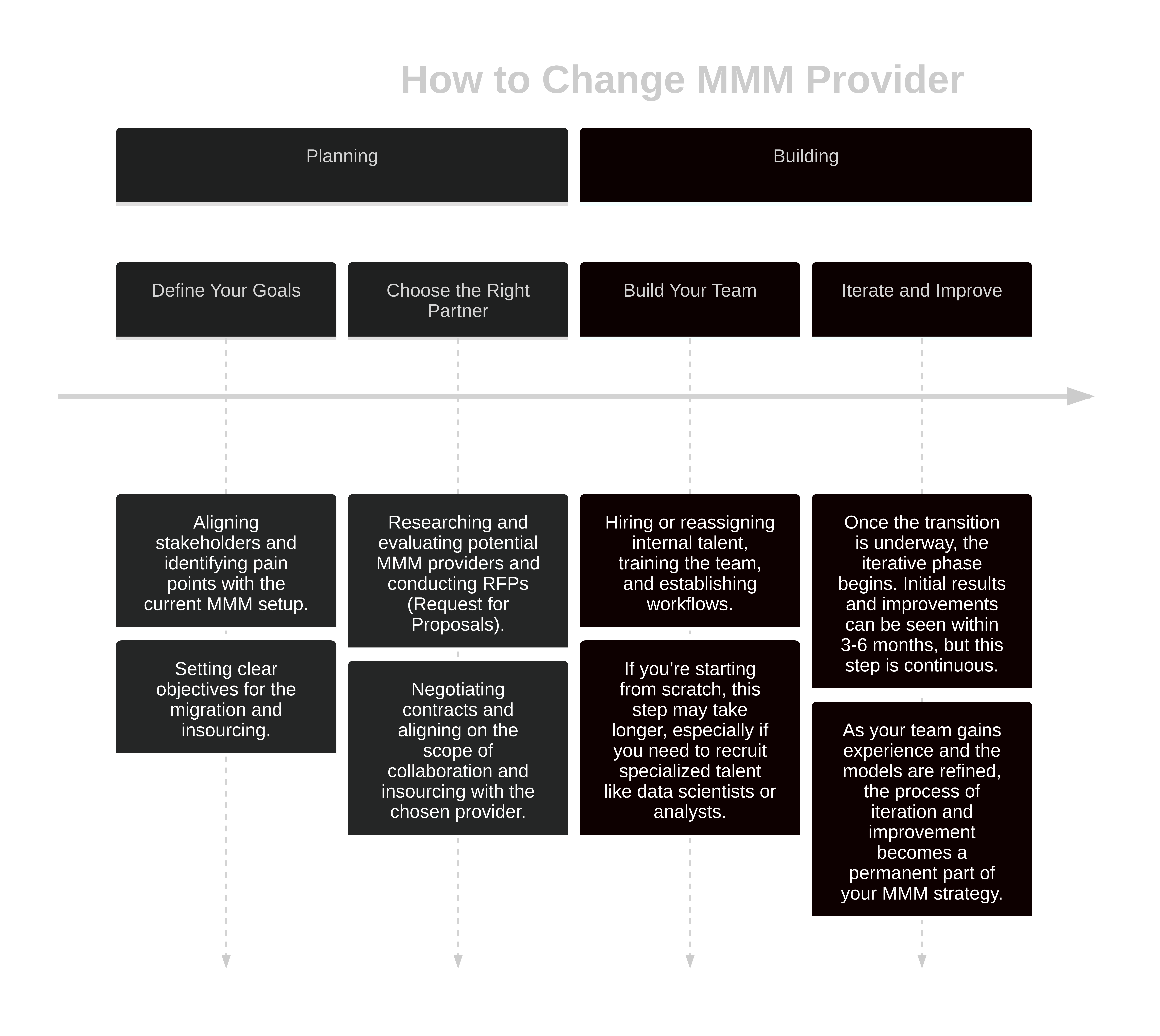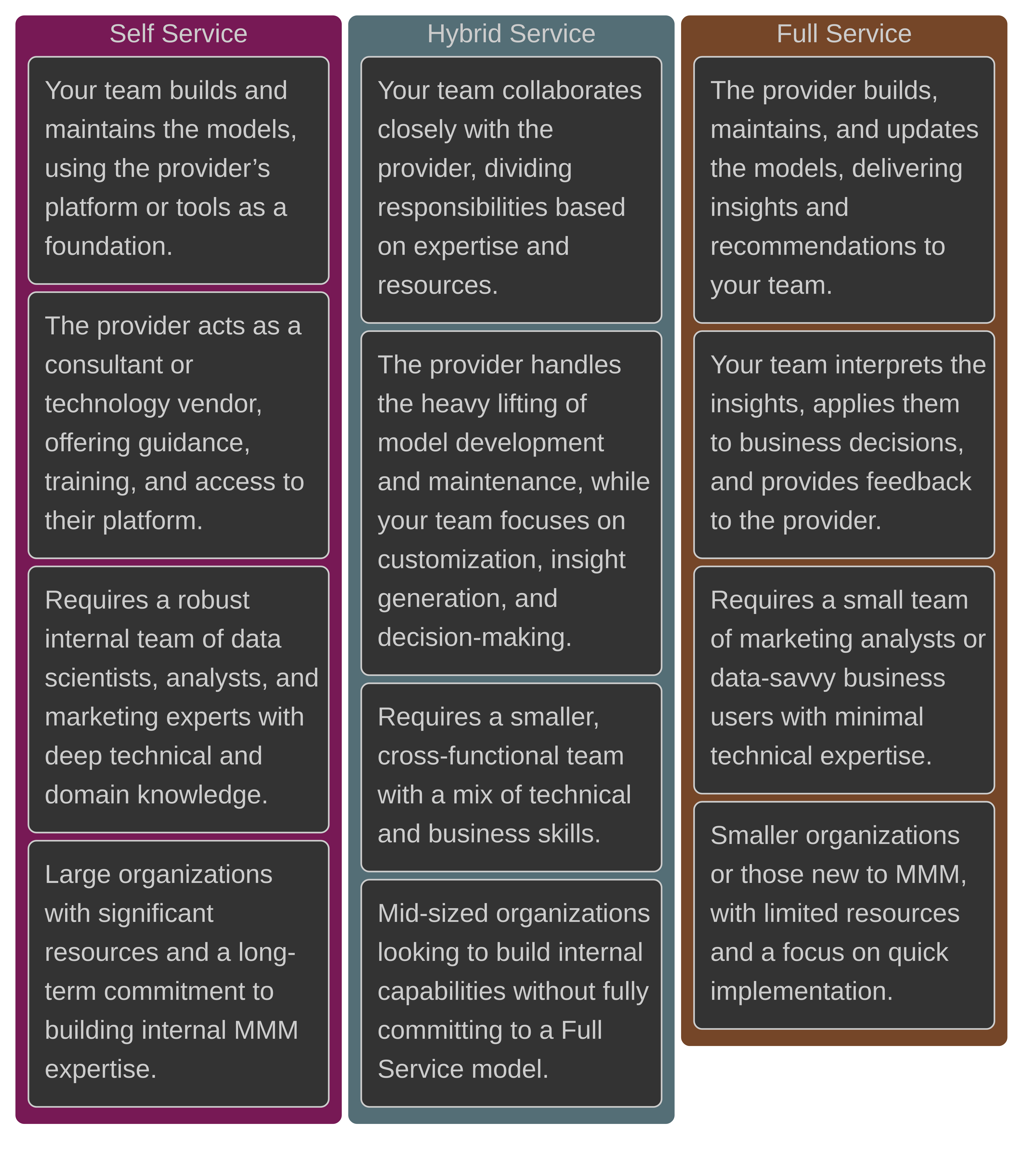Migrating MMM Providers and Inhousing Models
Migrating from one Marketing Mix Modeling (MMM) provider to another while simultaneously insourcing some of the modeling work is a growing trend among advertisers seeking greater control, flexibility, and deeper insights. This whitepaper explores the motivations behind this dual approach, highlighting the limitations of traditional outsourcing and the benefits of building internal expertise. By defining clear goals, selecting the right partner, and iterating on the process, advertisers can create a more powerful and adaptable MMM framework. The combination of external collaboration and internal capability-building not only enhances the quality and speed of insights but also future-proofs marketing strategies in an ever-evolving landscape. This paper provides a roadmap for advertisers considering this transition, emphasizing the strategic advantages and practical steps to achieve success.
Guide, Whitepaper, Info, MMM Platform, Advertisers
Introduction
When advertisers decide to switch Marketing Mix Modeling (MMM) (Bowman 2010) providers, it’s often because they’ve outgrown their current setup. Maybe the existing provider’s models no longer capture the complexity of their business, or perhaps the insights aren’t actionable enough. Whatever the reason, the decision to migrate is usually just the first step in a larger transformation. Increasingly, advertisers are also choosing to inhouse some of the modeling work (Watson 2020), partnering with the new provider to build custom solutions tailored to their specific needs. This whitepaper explores why this dual approach, migrating providers while insourcing some of the work, is becoming more common and how to do it effectively.
Why Migrate?
The first question to ask is: why switch providers at all? If you’re already using an MMM provider, why not just stick with them? The answer is usually some combination of dissatisfaction and ambition. Dissatisfaction because the current provider’s models aren’t delivering the insights you need, or because their approach feels too rigid or outdated. Ambition because you want to do more, e.g., more granular analysis, faster updates, better integration with other data sources.
The best MMM providers are like good consultants: they don’t just give you answers, they help you ask better questions. But if your current provider isn’t doing that, it’s time to look elsewhere. The tricky part is that switching providers isn’t like switching suppliers for a commodity. MMM is deeply intertwined with your business. The models are built on your data, and the insights they produce inform your decisions. Migrating to a new provider isn’t just a technical challenge; it’s a strategic one.
Why Inhouse?
At the same time, many advertisers are realizing that they don’t want to outsource all of their MMM work. There’s a growing trend toward insourcing some of the modeling, either by building internal capabilities or by working with the new provider to co-develop models. This makes sense for a few reasons.
First, insourcing gives you more control. When you rely entirely on an external provider, you’re at the mercy of their priorities and timelines. If they’re slow to update their models or reluctant to customize them, there’s not much you can do. By bringing some of the work in-house, you gain the ability to iterate faster and tailor the models to your specific needs.
Second, insourcing helps you build institutional knowledge. MMM isn’t just about the models. It’s about understanding how different factors such as ad spend, pricing and seasonality interact to drive outcomes. When you outsource all of that work, you miss out on the opportunity to develop deep expertise within your team. By insourcing some of the modeling, you can build a team that truly understands your business and can use MMM to its full potential.
Finally, insourcing can be a way to future-proof your MMM capabilities. The world of marketing is changing fast, and the models that work today might not work tomorrow. By building internal expertise, you ensure that you’re not just keeping up with the latest developments but actively shaping them.
How to Do It
Migrating providers and insourcing some of the modeling work is a complex process (Legris and Collerette 2006), but it can be broken down into a few key steps. The key is to balance speed with thoroughness. Rushing through the steps could lead to misaligned goals or poorly implemented models, while moving too slowly could delay the benefits of the transition. Breaking the process into manageable phases and setting clear milestones can help ensure a smooth and timely transition.

Define Your Goals
Before you start, you need to be clear about what you want to achieve. Are you looking for more granular insights? Faster model updates? Better integration with other data sources? The answers to these questions will shape your approach to both the migration and the insourcing. Early on in this step it’s important to include relevant stakeholders while setting clear objectives for the migration as well as engaging in expectation management (Errida and Lotfi 2021).
Choose the Right Partner
Not all MMM providers are created equal. Some are better at certain types of analysis, while others excel at integration or customization. When choosing a new provider, look for one that aligns with your goals and is willing to work with you to build custom solutions. The best providers will see insourcing not as a threat but as an opportunity to deepen their relationship with you.
As dramatic as it might sound the right provider can make or break your MMM migration and insourcing efforts. A good partner will not only deliver high-quality models but also help you build internal expertise and adapt to changing business needs. Take the time to choose wisely, and don’t be afraid to ask tough questions. The effort you put into selecting the right partner will pay off in the long run.
While evaluating providers, there are a few warning signs to be aware of, e.g., lack of transparancy, one-size-fits-all, poor communication and lack of insourcing support. Examples of these warning signs are given in the list below.
- If they’re unwilling to explain their methodologies or share details about their tools, proceed with caution.
- If they insist on using the same models for every client, they may not be flexible enough to meet your needs.
- If they’re slow to respond or dismissive of your questions, it’s a sign of how they’ll treat you as a client.
- If they’re resistant to helping you build internal capabilities, they may not be the right partner for your goals.
Choosing the right partner is a mix of art and science. It requires careful research, clear communication, and a willingness to invest time in building the relationship. But when you find the right fit, it can transform your MMM capabilities and set your business up for long-term success.
Build Your Team
Insourcing some of the modeling work means you’ll need to build or expand your internal team. This doesn’t mean you need to hire a dozen data scientists overnight. Start small, with a core team that can work closely with the new provider to co-develop models. Over time, you can expand the team as you take on more of the work.
When building your team to support the migration and insourcing of MMM work, it’s important to consider the level of internal capability you want to develop. There are three primary tiers of insourcing: Full Service, Hybrid Service, and Self Service. Each tier represents a different balance of internal and external responsibility, and the choice depends on your organization’s goals, resources, and long-term strategy. The key characteristics of each tier is outlined in Figure 2.

In the Full Service model, the external provider handles the majority of the MMM work, while your team focuses on using the insights to inform decision-making. This tier is the least resource-intensive but still allows for some level of internal involvement. The steps to implement are given below.
- Train a small team to interpret and act on the insights provided by the MMM models.
- Establish regular check-ins with the provider to ensure alignment on business goals and model outputs.
- Focus on building a feedback loop to refine the models over time.
The Hybrid Service model strikes a balance between internal and external responsibility. Your team handles some aspects of the MMM work, such as data preparation, insight interpretation, or specific model components, while the provider manages the core modeling and technical infrastructure. Implementing this model happens in the following three steps.
- Identify which aspects of the MMM process (e.g., data integration, insight interpretation) you want to insource.
- Build a core team with a mix of technical and business expertise to handle the insourced tasks.
- Establish clear communication and collaboration protocols with the provider to ensure seamless integration.
In the Self Service model, the majority of the MMM work is handled internally. Your team takes ownership of model development, maintenance, and interpretation, while the external provider plays a supporting role, offering tools, infrastructure, or specialized expertise as needed. As before we break down the implementation in three steps.
- Hire or reassign a dedicated MMM team, including data scientists, statisticians, and marketing analysts.
- Invest in training to ensure the team is proficient in the provider’s tools and methodologies.
- Establish clear workflows for collaboration with the provider, focusing on knowledge transfer and troubleshooting.
Iterate and Improve
Migrating providers and insourcing modeling work isn’t a one-off project. Rather, it’s an ongoing process. As you start working with the new provider and building internal capabilities, you’ll inevitably discover new ways to improve your models and your approach. The key is to stay flexible and keep iterating.
The tier you choose depends on your goals, resources, and appetite for risk. If you’re a big company with deep pockets and a long-term vision, go Self Service. If you’re a mid-sized company looking for flexibility, go Hybrid. If you’re small or just starting out, go Full Service.
The key is to be honest about what you can handle. It’s better to start small and scale up than to overcommit and fall short. And no matter which tier you choose, the most important thing is to keep iterating. The best teams are the ones that learn as they go.
The Payoff
The combination of migrating to a new provider and insourcing some of the modeling work can be transformative. By partnering with a provider that aligns with your goals and building internal expertise, you can create a setup that’s both powerful and flexible. You’ll get better insights, faster updates, and a deeper understanding of your business. And perhaps most importantly, you’ll be better positioned to adapt as the world of marketing continues to evolve.
The process isn’t easy, but the payoff is worth it. If you’re thinking about making the switch, now is the time to start. The sooner you begin, the sooner you’ll reap the benefits.